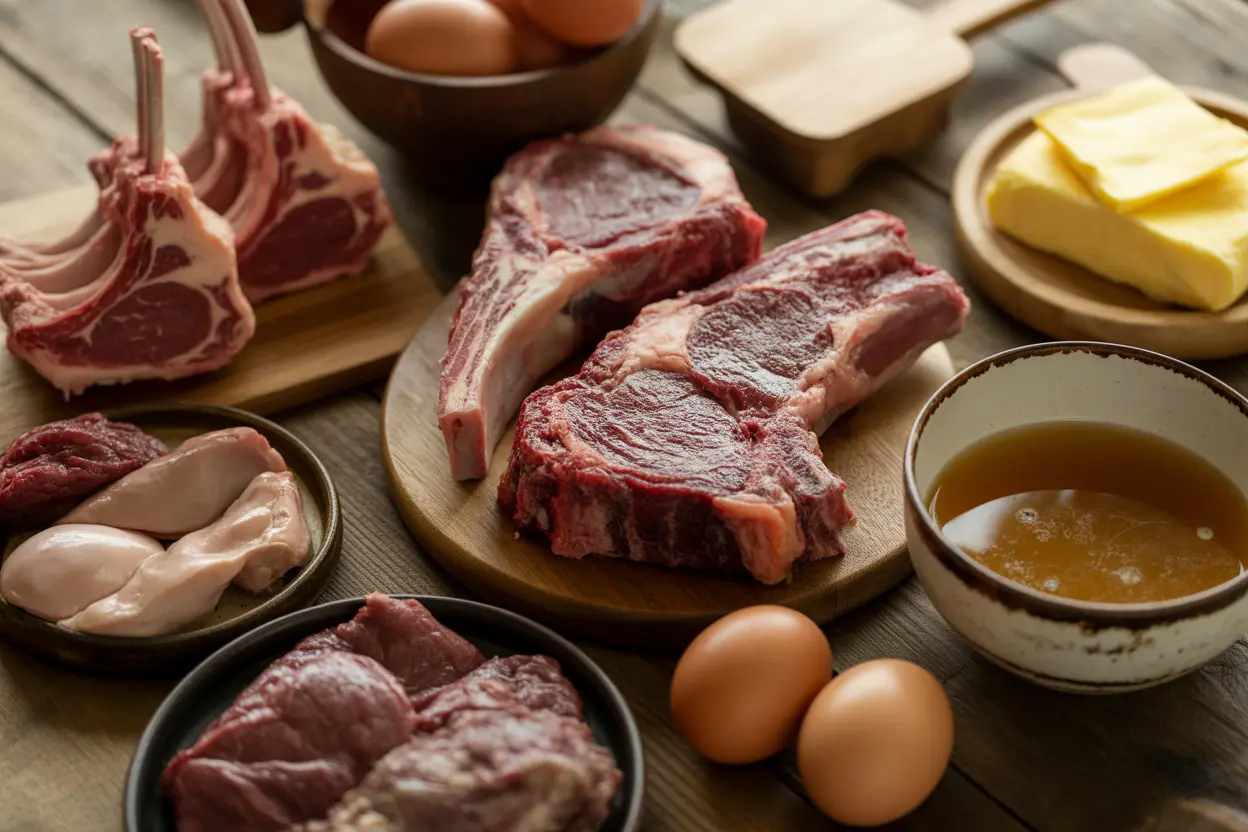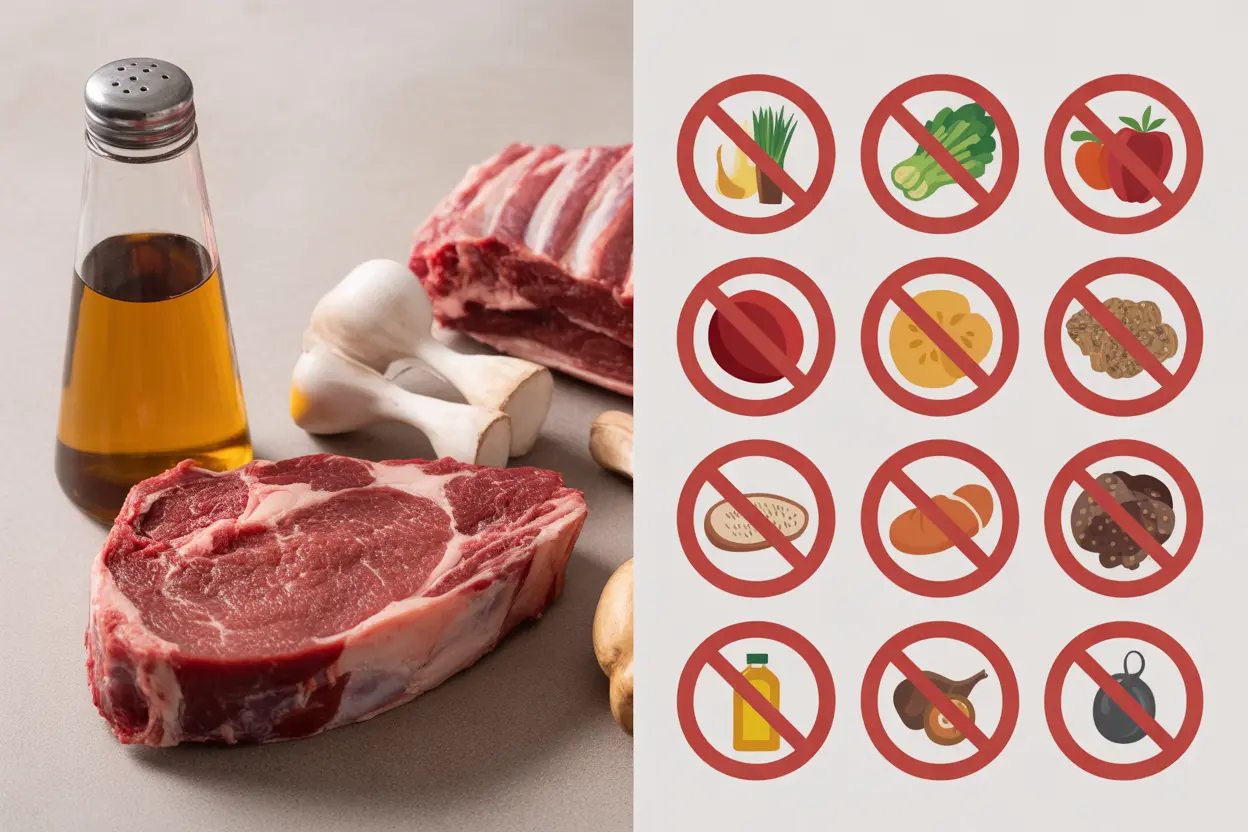Introduction to the Carnivore Diet
What is the Carnivore Diet?
Ever wondered what happens when you eat only animal products and ditch all the plants? That’s the carnivore diet in a nutshell — a zero carb diet focused entirely on meat and other animal-based foods. It’s a pretty radical switch from your usual balanced plate, but it’s been gaining heaps of attention lately. According to an overview of carnivore diet, the diet promises everything from weight loss to better mental clarity by cutting out carbs and plants completely.
But it’s not just about throwing away fruits and veggies. This carnivore diet guide will unpack how to navigate this unique journey successfully, ensuring you get the most out of animal-based nutrition while dodging common pitfalls.
Brief History and Popularity
The carnivore diet isn’t exactly a modern invention. Early humans likely survived primarily on animal foods before agriculture became widespread. Today, the diet has seen a resurgence thanks to advocates like Dr. Robert Kiltz, who publish core carnivore diet rules emphasizing simplicity and purity. Social media and communities rave about its potential health benefits, sparking curiosity in both novices and seasoned dieters alike.

Key Principles of the Carnivore Diet
Allowed Foods on the Carnivore Diet
So, what fills your plate on a strict animal-based diet? It’s mostly:
- Beef, pork, lamb
- Poultry and fish
- Eggs
- Organ meats like liver and kidneys
- Animal fats
- Bone broth
The emphasis is strongly on nutrient-rich, fatty cuts of meat that keep you energized and satisfied. For those curious about the nutritional benefits of organ meats, adding organ meat is a game changer for vitamins and minerals.
Foods to Avoid
On the flip side, the carnivore diet rules insist on steering clear of:
- Vegetables, fruits, grains, and legumes
- Sugars and sweeteners
- Processed foods and additives
- Vegetable and seed oils
These avoidance lists are important because the diet is designed to exclude all plant-based foods, focusing solely on what nature offers from the animal kingdom.
Do’s of the Carnivore Diet
Eat Only Animal-Based Products
When you start your carnivore diet journey, it’s essential to embrace the meat-only diet fully. Trust me, it’s tempting to sneak in a salad or fruit, but sticking to pure animal foods will help your body adapt more efficiently. If you need inspiration, dive into some easy and delicious meat-based meals to keep your menu exciting while staying on plan.
Prioritize Fatty Cuts of Meat
Fat is your friend here. Prioritizing fatty cuts of meat gives you energy and keeps hunger at bay. Think ribeye, brisket, and pork belly. Lean meats alone won’t cut it because your body needs fat for fuel, especially in this zero carb diet setting.
Stay Hydrated with Water and Bone Broth
Hydration on a carnivore diet is pivotal. Water should be your go-to, but don’t underestimate the benefits of bone broth. This nourishing liquid replenishes minerals and comforts your digestive system, making it a staple drink. Besides fluids, bone broth also delivers collagen and amino acids, perfect for joint and skin health.

Include Salt and Essential Electrolytes
Salt is the magic seasoning you don’t want to skip. Keeping electrolyte balance carnivore style means adding enough salt and considering supplements like potassium and magnesium. Checking a guide to balancing macronutrients can help you understand how to maintain this delicate balance.
Eat According to Hunger and Avoid Calorie Counting
Forget calorie counting! The beauty of the carnivore diet is eating intuitively. When you prioritize fats and proteins, hunger signals become your best guide. If you want some inspiration, you can explore meal ideas for simple meat dishes that satisfy your appetite without fuss.
Incorporate Organ Meats for Nutrient Density
Even if you’re all about steaks, don’t overlook organ meats. They pack a punch in nutrition and can prevent deficiencies. If you’re wondering why include organ meats, this resource spells out their powerhouse micronutrients.
Don’ts of the Carnivore Diet
Avoid All Plant-Based Foods
This seems obvious, but it’s easy to falter. No sneaking in even small amounts of plant foods — no veggies, fruits, grains, or nuts. The no plant foods diet approach is strict for a reason: plant fibers and carbs can interfere with the carnivore diet’s metabolic goals.
No Processed Foods or Additives
Processed foods are off-limits, even if they’re “keto-friendly” or low-carb. Avoid all preservatives, sauces, spices with additives, and anything “packaged.” Your body appreciates purity, and staying away from additives helps maintain that animal fats diet’s integrity.
Avoid Carbohydrates and Fiber Completely
Carbs are zero in this diet — that means no sugar, starch, or fiber. Fiber isn’t necessary here because the diet is meat-only, which can change gut function. If you’re curious about carnivore diet and gut health, be prepared for some adaptation.
Do Not Use Vegetable or Seed Oils
Vegetable oils like canola, soybean, or sunflower are high in inflammatory fats and don’t belong on the carnivore diet. Stick to animal fats like tallow, lard, or butter for cooking and flavoring.
Limit Dairy to Low-Lactose Products if Tolerated
Dairy is tricky. Some people thrive on it; others don’t. If you include dairy, choose low-lactose options like aged cheeses or heavy cream and monitor your tolerance closely. This carnivore diet dairy restrictions tip can prevent digestive upset.
Common Mistakes to Avoid on Carnivore Diet
Undereating Fat and Relying Too Much on Protein
Many beginners focus too much on protein without enough fat, leading to fatigue and hunger. Remember, fat vs protein carnivore balance defines your energy levels and satiety. Don’t be shy with fatty cuts!
Ignoring Hydration and Electrolyte Needs
Skipping salt and electrolytes can cause dizziness, cramps, or headaches. Staying hydrated and replenishing electrolytes is a must for feeling great on the carnivore diet.
Expecting Immediate Results Without Adaptation Phase
Give your body a few weeks to adjust. The transition can involve mood swings or digestive changes, but patience pays off. No instant magic — it’s a process that rewards persistence.
Health Considerations and Safety
Potential Benefits of the Carnivore Diet
Advocates report significant improvements in weight loss, mental clarity, reduced inflammation, and relief from some autoimmune symptoms. A meat-only diet may simplify digestion for some and regulate blood sugar effectively. These promising benefits have sparked growing interest but warrant personal experimentation.
Risks and Nutritional Deficiencies
Going all-in on meat can lead to missed nutrients like vitamin C and fiber, risking nutritional deficiencies carnivore style. There may also be concerns around cholesterol and heart health for some individuals. It’s crucial to monitor blood work and consult healthcare professionals about carnivore diet health risks to stay safe.
Tips for Successfully Following the Carnivore Diet
How to Transition onto the Diet
Start by cutting out carbs and processed foods gradually, then shift fully to animal-based foods. This gradual shift eases symptoms. Pair this with an authentic digestive and weight loss drink for extra support and comfort during transition.
Meal Planning and Recipe Ideas
Planning is your best friend here—batch cooking fatty meats and experimenting with carnivore diet recipes keeps boredom away. If you want creative ideas, check out a step-by-step guide to making sandwiches adapted to the carnivore lifestyle.
FAQs
What can you eat on a carnivore diet?
You can eat mainly animal products such as beef, pork, chicken, fish, eggs, and animal fats. Organ meats like liver and kidneys are recommended for added nutrition. Dairy can be included if tolerated, especially low-lactose varieties like hard cheese or heavy cream. Foods like vegetables, fruits, grains, nuts, and sugars are not allowed.
Is the carnivore diet healthy?
The carnivore diet offers potential benefits like weight loss, reduced inflammation, and improved mental clarity for some people. However, it lacks fiber and certain vitamins found in plants, which may lead to nutritional deficiencies over time. Its healthiness varies by individual, and medical guidance is advised.
How do you start a carnivore diet?
Start by gradually removing carbs and processed foods from your meals, then shift fully to animal-based foods. Drink plenty of water and consider adding bone broth. Focus on eating fatty cuts to provide energy, and give your body time to adapt to the new way of eating.
What are the side effects of the carnivore diet?
Common side effects include headaches, fatigue, and digestive changes during the initial adaptation phase. These often improve after a few weeks. Electolyte imbalance may cause cramps or dizziness, so adequate salt and minerals are important.
Can you drink coffee or tea on the carnivore diet?
Coffee and tea are not strictly animal-based but many following the carnivore diet choose to include them in moderation. Some avoid them to keep the diet stricter, while others find they don’t cause issues. It depends on personal tolerance and goals.
Conclusion
The carnivore diet guide clearly defines a lifestyle that demands exclusive consumption of animal-based products while eliminating all plant foods. This unique approach offers potential benefits, such as weight loss and inflammation reduction, but also comes with risks of nutritional gaps that require careful planning and monitoring. Following key do’s and don’ts—like prioritizing fatty cuts, avoiding processed foods and carbohydrates, and staying hydrated—can make the journey smoother and more sustainable. Always remember to consider your personal health and consult professionals when diving into this strict, intriguing way of eating.
